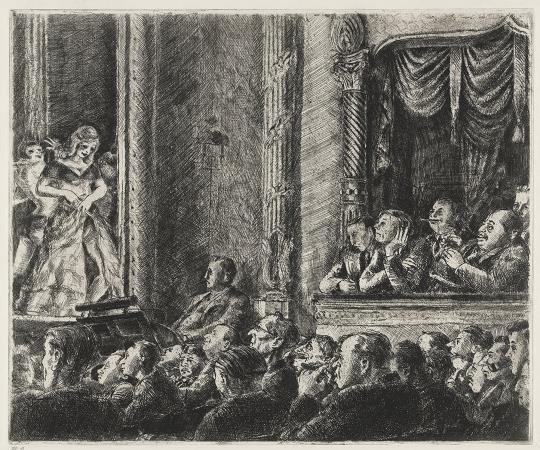Irving Place Theatre. The Irving Place Theatre was located at the southwest corner of Irving Place and East 15th Street in the Union Square neighborhood of Manhattan, New York City. Built in 1888, it served as a German language theatre, a Yiddish theatre, a burlesque house, a union meeting hall, a legitimate theatre and a movie theatre. It was demolished in 1984. The original building on the site was Irving Hall, which opened in 1860 as a venue for balls, lectures, and concerts. It was also for many years the base for one faction of the city's Democratic Party. The facility was rebuilt, and opened as Amberg's German Theatre in 1888 under the management of Gustav Amberg, as a home for German-language theatre. Heinrich Conried took over management in 1893, and changed the name to Irving Place Theatre. The first night of the play Narrentanz by Leo Birinski took place here on November 13, 1912. In 1918 the facility became the home of the Yiddish Art Theater company under the management of Maurice Schwartz. By the 1920s burlesque shows were offered alongside Yiddish drama. Composer-arranger Harry Lubin, of The Outer Limits fame, was musical director of the theater during the 1920s and 1930s. Clemente Giglio converted the theatre in 1939 into a cinema to present Italian films. In 1940 it was taken over by a group of non-Equity actors, the Merely Players, whose productions were picketed by the theatrical unions. During World War II it presented a steady program of mixed bills of Soviet propaganda and French films, as well as weekly folk dance sessions. Comparative Study on ethnic stages in the United States show ethnic stage activity spanning over a century and a half. Ethnic stages were created by and for immigrants themselves coming from Europe, Latin America, and Asia. Ethnic stages resonated strongly with immigrants because it reflected on their concerns and experiences. Ethnic stages were primarily designed to have immigrant-themed works for recently arrived immigrant audiences. Through the ethnic stage, immigrants maintained and expanded their cultural memory. Immigrant influence on American society can be pinpointed to places like Swede Town; Little Germany; Little Italy; and chinatown. Despite the overt, clear presence of immigrant communities all over America, the ethnic stage was hidden and closed-off from outsiders. Those not part of specific ethnic communities were not aware or interested in that community's theater. Ethnic theater was undermined by immigrants themselves. First generation immigrants preferred plays in their homeland language while second generation immigrants favored mainstream theater in the English-language. Despite this division, ethnic theater prospered in the face of continuous mass immigration, lasting several decades or a century. Immigrants and their descendants never completely lost interest in ethnic theater but with the advent of film, immigrants, like their American counterparts attended American Motion Pictures, providing them insight into their new home and assimilating them. The vaudeville was also another competing form of entertainment eager to lure in immigrants as audience members. The vaudeville and the ethnic theater played different social functions. Ethnic stages such as Yiddish and Italian theater sought to preserve cherished aspects of old-world culture. Through the celebration of shared values, ethnic theaters gave immigrants a sense of community and solidarity in the face of increasingly chaotic and diverse every day life in the city. Vaudevilles, on the other hand, served to interpret ethnic communities via ethnic caricatures through comedy. At times, ethnic communities protested their caricatures in the vaudeville but nonetheless were among the audience members of the vaudeville. Just like ethnic theater, the vaudeville offered a glimpse of immigrant life though, the vaudeville heavily stressed ethnic caricatures. Immigrants were drawn to the vaudeville primarily because these ethnic caricatures though unfavorable, bore a realistic resemblance to the immigrants and they would encounter on the streets and neighborhoods. In 1893, Polish immigrant, Heinrich Conried changed the theater's name to Irving Place Theater. He worked as a director and manager, establishing the theater's success and financial stability until 1903. Though Conried aimed to primarily attract New York's German-speaking population, not all were regular theatre-goers, so he devised a program with a frequent change of bill to expand his audience.
more...



